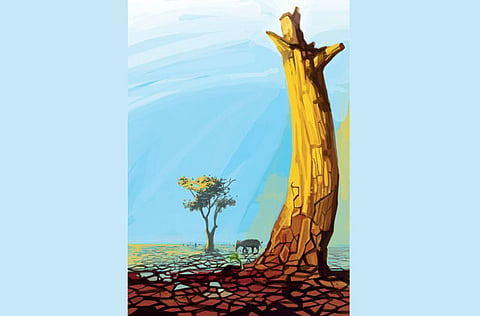A mere 10 inches from extinction
Earth's topsoil that sustains agriculture is rapidly being degraded through over-cultivation, over-grazing and rampant deforestation

It is the forgotten environmental crisis — but probably the most important one of all. There's constant, justifiable concern about climate change, the growing scarcity of fresh water, the loss of wildlife, and pollution of the air and seas. But rarely does such attention come down to earth.
Humanity, like all terrestrial life, depends utterly on the alarmingly thin coating that dusts the Earth's crust. Just six to 10 inches of topsoil — in the words of Luc Gnacadja, who leads on the issue for the United Nations — is normally "all that stands between us and extinction".
And we are going to need it more and more. As population and demand grow, the world will have vastly to increase food production. Already demand is outstripping supply, even in years of good harvests, forcing up prices and hunger alike.
We cannot afford, literally, to lose ground. Yet about a quarter of the world's agricultural land has already been degraded, mainly through over-cultivation, over-grazing, and the felling of trees that bind soil to the ground, help rainwater to penetrate, and shield it from winds that would blow it away.
Shocking loss
In the 1970s and 1980s alone, the world lost some 500 billion tonnes of topsoil — equivalent, I'm told, to the entire covering of US cropland. And still about 12 million hectares — an area three times the size of Switzerland — becomes useless to agriculture every year.
Most of the damage is in the drylands that host nearly half the world's agriculture, causing patches of man-made desert to erupt and merge. Partly as a result, about four fifths of the world's recent conflicts have broken out in arid areas.
The Darfur war provides a clear example: land degradation, exacerbated by climate change, brought the Sudanese desert 100 kilometres south over four decades, driving the nomadic people who had lived off the newly barren areas on to the land of other tribes.
The destruction is as almost old as civilisation itself. The first known written story, the Epic of Gilgamesh, warned against felling the forests of ancient Mesopotamia. It was disregarded and Uruk, the city where it was first told, is now just a bump in the desert shrouding where people first set plough to the ground.
But cross Asia to the world's second great cradle of agriculture and you'll hear a different — far more hopeful — tale. It starts conventionally enough. China's Loess Plateau, where the earth was first tilled 10,000 years ago, was long known as the most eroded place on the planet: 600 million tonnes of soil washed into the Yellow River every year.
Some hope
But now a staggering transformation is taking place. Just 15 years of work by the local people — backed by the Chinese government and the World Bank — has made an area the size of Belgium fertile again, through such measures as terracing the barren slopes and building small dams, a ban on felling trees and the planting of new ones, and setting aside land for nature.
Yields and incomes have quadrupled. John Liu, a film-maker who has been documenting the transformation, told a conference on ‘human security' in Caux, Switzerland, this month that the results had "far exceeded expectations".
Other speakers had similarly surprising experiences. Yacouba Sawadogo — an innovative, illiterate and eloquent small farmer from Burkino Faso — experimented with digging holes every metre across his barren land and filling them with manure.
His yields of millet and sorghum quickly jumped from nothing to 1,500 kilograms a hectare in years of good rains, and tens of thousands of his neighbours have followed suit. And Dr Chris Reij, of Amsterdam's Vrije University, who has worked in the Sahel for over 30 years, described how farmers in Niger had greened five million hectares of unproductive land simply by protecting naturally sprouting tree seedlings from being eaten by goats.
The result: an extra 500,000 tonnes of grain a year — enough to feed at least 2.5 million people. He reckons that two thirds of the world's degraded land could be similarly restored. But encouraging as the grassroots greening has been, it remains piecemeal, and largely unknown — still less supported — by local governments, let alone the world at large.
In 1992, the Rio Earth Summit agreed a treaty to reverse land degradation — but it has not received a thousandth of the attention paid to the agreements on climate change and biodiversity struck at the same time.
Perhaps this is about to change. Gnacadja, who heads the treaty's secretariat, has persuaded the UN General Assembly to host a special one-day summit on the issue in September.
Is it too much to hope that the world finally cops on to both the gravity of the crisis and the immense potential for reversing it?
— The Telegraph Group Ltd, London 2011
Sign up for the Daily Briefing
Get the latest news and updates straight to your inbox



